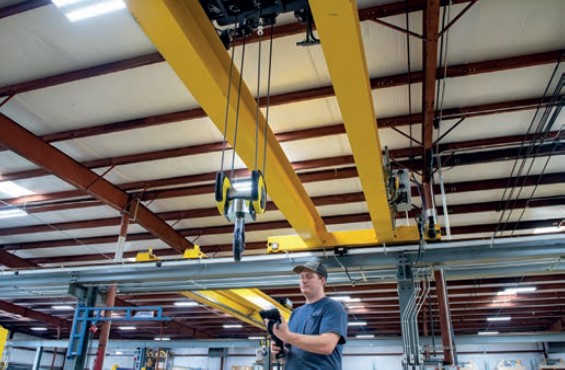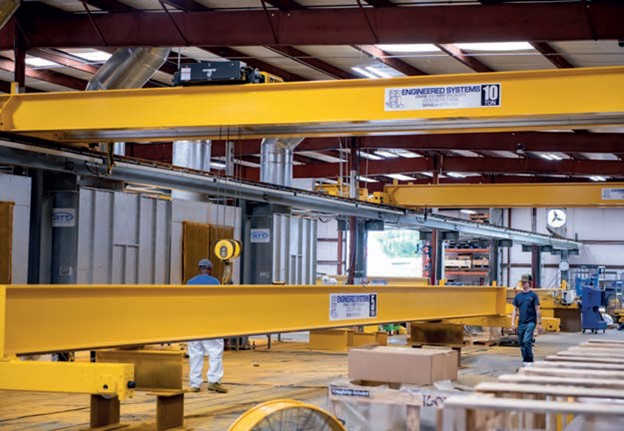Crane supplier purchases low-headroom cranes to expand factory production capacity
This sentence sounds very strange. Crane suppliers are companies that supply cranes to others. Why do they need to purchase cranes from other suppliers for production? I don’t know the whole story, but when I saw this news today, I felt the need to share it. In fact, just as the division of labor in society is becoming more and more detailed, crane suppliers often cannot provide all types of crane products, which gives them opportunities to cooperate with each other. If our customers give us some needs that we cannot meet, but we have familiar partners who can provide corresponding products, then we can still complete the business. This process is not complicated, but it is indeed interesting. Today I will describe the process of this case in detail, hoping to help customers understand our crane industry.
Crane supplier A installs company B’s cranes in a new factory
Crane supplier A – a full-service crane and hoist provider – looked no further than its manufacturing partner, B, when it required new lifting equipment to facilitate increased capacity for crane building at a new site located in Duncan, South Carolina.
The two new lines, which are in addition to three existing lines, are 300 feet long and will be dedicated to the manufacture of profile cranes. The crane support structure, box girder crane and V-beam will be produced at one of Crane Supplier A’s other plants.
Engineered systems need a solution that gives them the best room to grow in the industry. It is also interested in introducing state-of-the-art monitoring technology and remote connectivity to achieve the greatest return on investment possible.

They needed to modernize existing buildings on the property to meet production needs. The biggest challenge was the height of the building’s roof and the resulting headroom issues.
They have encountered very similar challenges on their past two expansions, and like anyone else installing overhead cranes, they need to consider capacity, headroom and price.
Crane Supplier A selects a crane package from Crane Supplier B. The range’s “excellent headroom” was a driving factor in selection, although hoist monitoring and remote access, among other features, were also important considerations.
Six double-girder overhead cranes with a capacity of 10 tons and spans of 48 feet are equipped with Company B’s remote monitoring system, Overhead Lifting Information (OLI), which will provide data so that predictive maintenance and on-site and remote problem diagnosis can be implemented.

Company A chose Company B’s energy chain, which eliminated the traditional energy chain and placed the rails within the bridge web, thereby increasing the headroom of the crane, giving the cranes an overall cleaner appearance, and protecting the wires from accidental contact with equipment or objects in the area.
The expansion, uplifted by its new cranes and hoists, will position Company A for continued growth, especially as dedicated crane builders will be in high demand as consolidation of the wider market is driven by investment banking groups.

What collaborations exist among crane suppliers?
Cooperation between crane suppliers can involve many aspects. Here are some common cooperation methods:
- Supply chain cooperation: Suppliers can establish supply chain cooperation relationships to jointly ensure the production and supply of cranes. This cooperation may include raw material procurement, component manufacturing, product assembly and final product delivery. By sharing resources, optimizing production plans and coordinating logistics, suppliers can reduce costs, improve efficiency and responsiveness.
- Technology R&D cooperation: Suppliers can jointly carry out technology R&D cooperation to promote technological innovation and upgrading of cranes. This cooperation may involve research on new materials, new processes, intelligent technologies, etc. to improve the performance, safety and reliability of cranes.
- Marketing cooperation: Suppliers can jointly conduct marketing cooperation to expand the market share and influence of cranes. This cooperation may include joint exhibitions, co-organizing promotional activities, sharing customer resources, etc. to enhance brand awareness and product competitiveness.
- After-sales service cooperation: Suppliers can establish an after-sales service cooperation mechanism to jointly provide customers with high-quality after-sales services. This cooperation may involve product installation, debugging, repair, maintenance, etc. to ensure that customers receive satisfactory experience and support during use.
